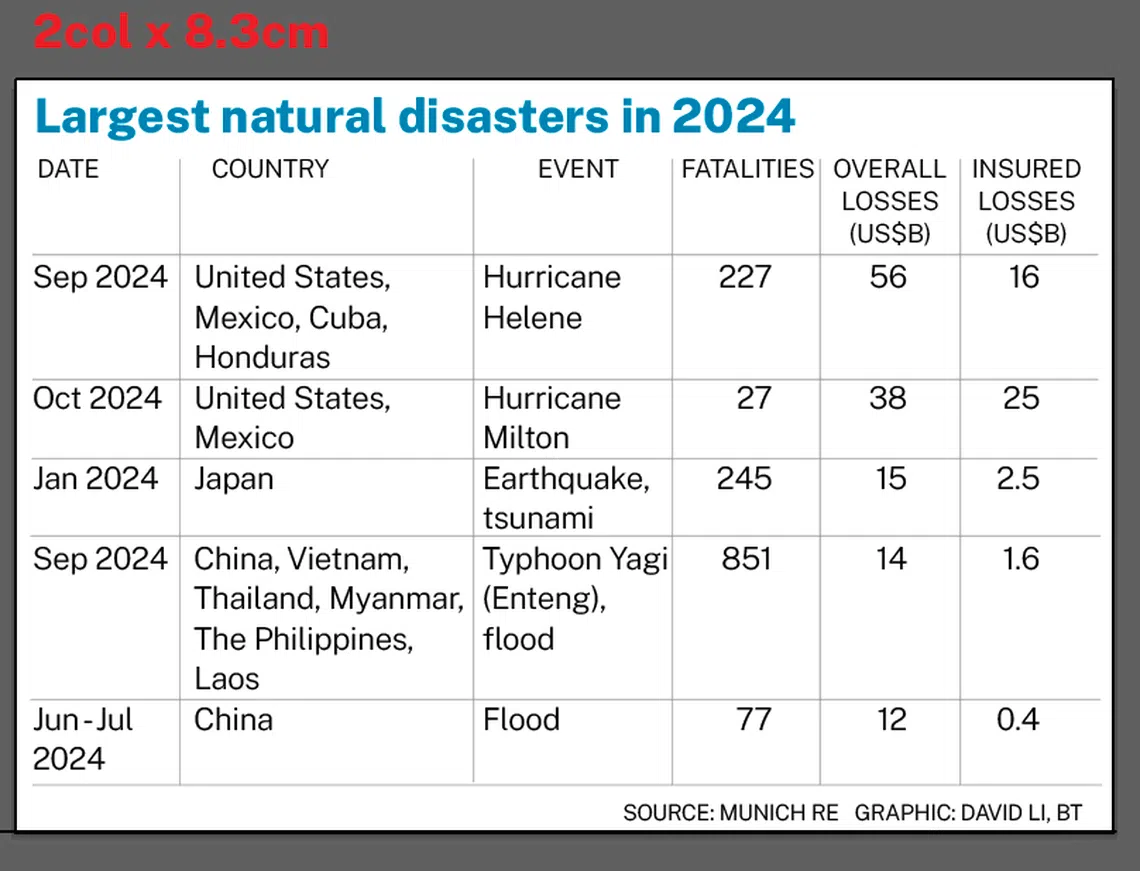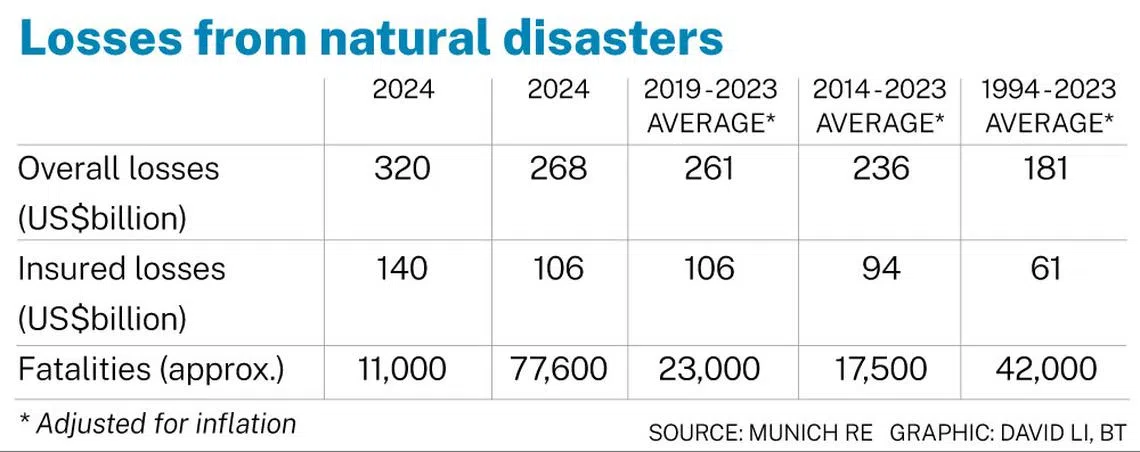Losses from natural disasters in Asia-Pacific, Africa soar to US$91 billion in 2024: Munich Re
While overall losses have risen, so have insured losses

THE Asia-Pacific and African region experienced total losses of US$91 billion from natural disasters in 2024, much higher than losses that amounted to US$66 billion the previous year.
Insured losses stood at US$16 billion, compared to US$10 billion in 2023, indicated a recent report by reinsurance company Munich Re.
Among the top five natural disasters which caused the most amount of losses in 2024, three were in Asia.
These are:
- The Noto earthquake in Japan, which led to US$15 billion in overall losses
- Typhoon Yagi across several countries in Asia-Pacifc that resulted in losses of US$14 billion
- Floods in China, which brought about US$12 billion in damages
The two most devastating natural disasters were Hurricane Helene and Hurricane Melton, which swept through United States, Mexico and other Central American countries between September and October last year.

The Noto earthquake, which struck Japan on Jan 1 last year, was the third costliest natural disaster, with overall losses estimated at US$15 billion, with insured losses totalling around US$2.5 billion.
Typhoon Yagi had the highest death toll with about 850 people killed when it tore though the Philippines, Vietnam, Myanmar and parts of southern China.
With total losses of US$14 billion, Typhoon Yagi was the fourth most expensive disaster of the year, but only a small fraction (US$1.6 billion) was insured.
Severe flooding in China, mainly in the southern and south-eastern regions, affected tens of millions of people caused overall losses of US$12 billion, of which only a small percentage were insured.
SEE ALSO
In addition to these natural disasters, losses in Asia-Pacific were driven by an extreme flood catastrophe in the United Arab Emirates, with Dubai particularly hard hit. Neighbouring countries were also affected, bringing total losses to US$8.3 billion, of which US$2.8 billion was insured.
Overall and insured losses have risen
Across the globe, natural disasters caused losses of US$320 billion in 2024, of which US$140 billion was insured.
This is higher than the US$268 billion of total losses experienced in the previous year. The overall and insured losses in 2024 were also considerably higher than the inflation-adjusted averages of the past 10 and 30 years, indicated data from Munich Re.

Hurricane Helene resulted in the largest overall losses at US$56 billion, of which US$16 billion was insured.
While Hurricane Milton was slightly weaker than Hurricane Helene when it made landfall in the US state of Florida only two weeks later, it produced the highest level of insured losses of the year, totalling US$25 billion. Total losses for Hurricane Milton came in at US$38 billion.
North America, including Central America and the Caribbean, experienced US$190 billion in losses, accounting for the highest share of global natural catastrophe losses at about 60 per cent. About US$108 billion was insured.
Besides Hurricanes Helene and Milton, severe thunderstorms also caused enormous damage. In the US alone, they were responsible for US$57 billion in losses, US$41 billion of which was insured.
The report stated that non-peak events such as severe thunderstorms are now causing cumulative damage equivalent to a severe hurricane year after year – with insurers bearing a significant share of the costs.
In Europe, natural disasters destroyed assets worth US$31 billion last year, of which US$14 billion was insured. The most serious catastrophe was the extreme flooding in Spain near the provincial capital of Valencia, with the total damage amounting to around US$11 billion, of which US$4.2 billion was insured.
Munich Re’s report stated that in 2024, annual average temperatures hit 1.5 deg C above pre-industrial levels for the first time, and temperatures will surpass the previous record in 2023.
“Our planet’s weather machine is shifting to a higher gear. Everyone pays the price for worsening weather extremes, but especially the people in countries with little insurance protection or publicly funded support to help with recovery.”
Munich Re chief climate scientist Tobias Grimm
In many regions, severe thunderstorms and heavy rainfall are becoming more frequent and more extreme. Although tropical cyclones are not generally increasing in number, the proportion of extreme cyclones is growing. They, in turn, are rapidly intensifying and bringing extreme precipitation with them, the report added.
Munich Re’s chief climate scientist Tobias Grimm said that the higher the temperature, the more water vapour and therefore energy is released into the atmosphere.
“Our planet’s weather machine is shifting to a higher gear. Everyone pays the price for worsening weather extremes, but especially the people in countries with little insurance protection or publicly funded support to help with recovery. The global community must finally take action and find ways to strengthen the resilience of all countries, and especially those that are the most vulnerable,” he added.
Decoding Asia newsletter: your guide to navigating Asia in a new global order. Sign up here to get Decoding Asia newsletter. Delivered to your inbox. Free.
Copyright SPH Media. All rights reserved.





